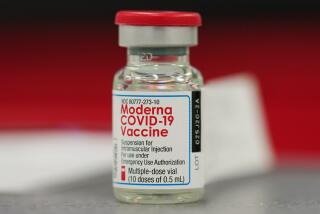U.S. Urges Wider Use of Cholesterol Drugs
- Share via
Government researchers Tuesday announced new guidelines for cholesterol screening and treatment that could nearly triple--to about one in five U.S. adults--the number of patients prescribed cholesterol-lowering drugs.
The national report, which doctors say will guide practice for years to come, is an ambitious effort by medical experts to intensify prevention and early treatment of a disease that claims the lives of 1 million Americans each year--costing $105 billion in treatment. About half of all Americans will eventually die of some form of cardiovascular disease, researchers say.
But some doctors criticized the new guidelines, saying they would impose a costly burden on the health system and may promote the use of drugs in some patients who would be fine without them.
The guidelines, from a national panel of prominent heart researchers, are testimony to the enormous impact over the last decade of a class of drugs called statins. Research has shown that the drugs sharply lower levels of LDL, or “bad,” cholesterol in most people, cutting the risk of heart disease by 20% to 30% on average, and significantly extending the lives of those who remain at risk.
When the government last published such comprehensive guidelines, in 1993, doctors still disagreed about the importance of cholesterol control in managing heart disease risk.
“Now we have piles of clinical trials with the statin drugs showing that lowering LDL significantly reduces the risk of heart attacks, of stroke, of hospitalization, all across the board,” said Dr. Scott Grundy, a cholesterol researcher at the University of Texas Southwestern Medical Center in Dallas and head of the government panel. “That is the biggest difference between what we know now and what we knew then.”
Some doctors, however, are cautious about prescribing the drugs in many patients because of the unknowns. Statins often are taken indefinitely, for 15 years or longer, and not a lot is known about their possible long-term health effects. In the short term, the drugs can cause liver problems, muscle aches and pains, and, in rare instances, a debilitating muscle-wasting condition.
For the vast majority of people, however, statins, including Lipitor, Zocor and Mevacor, have so few adverse effects that they’ve become among the best-selling drugs on the market.
“You can get reductions in LDL of up to 70% on some of the stronger statin drugs,” which can cut heart disease risk by more than half, said Dr. Karol Watson, co-director of the UCLA program in preventive cardiology.
Currently, about 12 million Americans take cholesterol-lowering drugs. The guidelines could raise that figure to 36 million.
Low-density lipoproteins (LDL) earn their dark reputation by delivering fatty deposits to artery walls, restricting blood flow over time and increasing the risk of heart attack and stroke. Their good twin, high-density lipoproteins (HDL), help the body carry those deposits away. Both substances are important predictors of cardiovascular disease, which remains the leading killer of Americans, according to the American Heart Assn.
The guidelines, devised by a panel of 27 experts for the National Institutes of Health, were intended to provide a cholesterol management road map for doctors and patients. The results are published today in the Journal of the American Medical Assn.
The panel made no changes in existing guidelines covering the risks associated with various LDL cholesterol levels: scores below 100 are considered optimal, and those above 160 are considered high. Total cholesterol figures were also unchanged: below 200 is considered desirable, and over 239 is considered high.
The most significant recommended change was in the type of patients considered the best candidates for drug therapy. Under prior guidelines, this group included heart disease patients; people with LDL scores of 190 or higher; and those with at least two risk factors for heart disease, such as obesity or a family history of disease, whose LDL score remained at 160 or more after dietary treatment.
The guidelines add several groups: people with diabetes who have no symptoms of heart disease; people with some evidence of vascular plaque or thickening, without symptoms; and those with at least two risk factors whose 10-year projected risk of developing disease is 20% or higher, based on factors such as age, gender and systolic blood pressure.
For all of these people, the panel recommends a target LDL treatment level of 100. That translates into more than a 50% reduction for some. The guidelines stress that doctors should prescribe lifestyle changes. For example, a diet rich in fruits, vegetables and whole grains, plus regular exercise, can lower LDL by up to 30% in some people. But sharper decreases often require drug therapy as well, many doctors say, especially in those at very high risk.
Not everyone is eager to use drugs to treat healthy people. “I just don’t think we have the data to say that healthy people with two risk factors would benefit significantly from having their LDL lowered to 100,” said Dr. Rita Redberg, a cardiologist at UC San Francisco.
Another concern is that long-term treatment with the cholesterol-lowering drugs would be expensive. At about $3 a pill, a statin regimen runs about $100 a month.
Another concern is that people will forsake lifestyle changes for the easy out of taking a pill. “As good as these drugs are, you can be on them and still eat your way to a heart attack,” said Grundy.
The panel also urged doctors to:
* Identify people with “metabolic syndrome,” whose characteristics include a big belly, high concentration of fatty compounds in the blood, and elevated blood pressure. These people are at elevated risk for heart disease, the panel concludes.
* Avoid hormone replacement therapy as a replacement for cholesterol drugs. For years, such therapy was thought to protect women from heart disease, and the previous guidelines recommended it, Watson said. But recent studies have shown no heart-protective benefit.
(BEGIN TEXT OF INFOBOX / INFOGRAPHIC)
New Cholesterol Guidelines
The government’s guidelines expand the definition of people considered good candidates for aggressive cholesterol-lowering drug treatment.
*
Under 1993 guidelines:
* Heart disease patients
* People with LDL scores of 190 or higher
* People with two or more risk factors for heart disease (such as family history, elevated blood pressure, obesity) and LDL scores of 160 or higher after dietary therapy
*
Additional categories under 2001 guidelines:
* People with diabetes who do not have heart disease
* People with evidence of asymptomatic arterial thickening or buildup, usually seen by imaging technology
* People with two or more risk factors for heart disease whose projected
10-year heart disease risk is 20% or higher. The 10-year risk is calculated from a combination of factors, including age, gender, smoking, HDL cholesterol and systolic blood pressure.
Source: National Cholesterol Education Program






